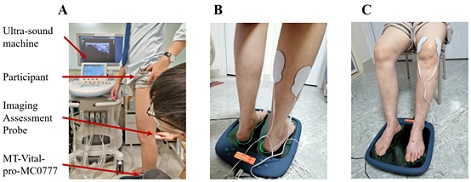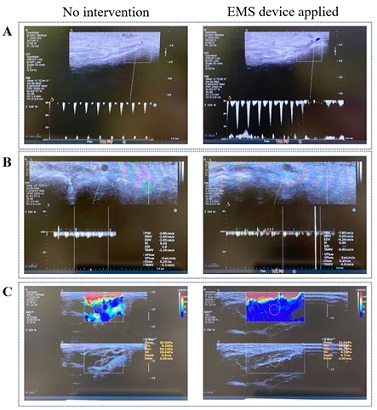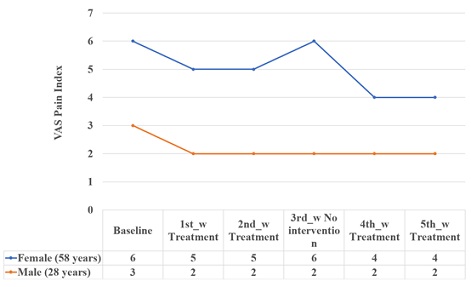
EMS Device (MT-Vital-pro-MC0777) Improves Lower Limb Circulation, Muscle Stiffness and Pain
*Corresponding Author(s):
Zou LiOrthopaedics And Traumatology, The Chinese University Of Hong Kong, Hong Kong
Email:lizou@cuhk.edu.hk
Abstract
Introduction: This study aims to evaluate the effectiveness of Electrical Muscle Stimulation (EMS) device (MT-Vital-pro-MC0777) on improving the lower limb condition. The mentioned device provided EMS signals to the soles of the feet and lower limbs.
Materials and Methods: The EMS device was applied for a subject of chronic lower limb pain (male, 29 years) to measure the changes of the blood circulatory system and muscle stiffness of the lower limb. An ultrasound machine was used to measure the imaging results of the circulation and muscle stiffness before and after the application of this EMS device. Then two subjects (male, 29 years, and female, 58 years) with the chronic lower limb pain were recruited in this study for a five weeks self-comparison study. The treatment time was 30 minutes every day with a moderate EMS signal. The Visual Analog Scale (VAS) pain index was applied to test the changes in pain.
Results: The imaging result shows the circulation of lower limb was improved significantly during our device application, the muscle stiffness of the lower limb was released after use this device. The VAS pain results of the chronic lower limb pain and related symptoms were reduced for the five weeks self-comparison study.
Discussion and conclusion: The imaging results suggest that this EMS device can improve the circulation and muscle stiffness of lower limb. In addition, this EMS device can reduce the pain in the lower limb, which will be beneficial for the subjects with neuropathic pain of lower limb and related degenerative diseases.
Keywords
Degenerative diseases; Electrical muscle stimulation; Lower limb pain; Medical device; Pain relief
Introduction
Chronic lower limb pain, often accompanied by compromised circulation, imposes a substantial burden on individuals' quality of life [1]. Traditional treatment typically focuses on pain management and circulation improvement, such as physical therapy shown wide effectiveness [2]. However, the advances in medical technology have introduced Electrical Muscle Stimulation (EMS) devices as a potential solution for addressing these challenges [3].
EMS involves the application of electrical impulses to the muscles, leading to muscle contractions [3,4]. This technology has seen extensive use in various therapeutic settings, including rehabilitation, sports medicine, and pain management [4,5]. It offers a non-invasive and drug-free approach that has shown promising results in improving circulation and reducing pain in the lower limbs [6-8]. Nakanishi N et al., studied a two-center randomized controlled trial design and collected data on muscle strength, muscle thickness, and muscle cross-sectional area. The findings demonstrated that EMS had a positive impact on muscle mass and strength in both the upper and lower limbs of critically ill patients. This research provides valuable insights into the potential benefits of EMS in preserving muscle mass and function in critically ill individuals [9]. Ahmed S. et. al. analyzed various studies and found that EMS techniques, including electroacupuncture and Transcutaneous Electric Stimulation (TENS), were effective in improving the conditions of patients with myofascial pain. But electroacupuncture showed greater benefits compared to TENS. This review provides evidence supporting the effectiveness of EMS techniques in managing pain and tenderness at the myofascial trigger point [10]. Hardy et. al. utilized a split body randomized control trial design, where one side of the body received EMS treatment while the other side served as a control. The findings suggest that post-operative EMS can help attenuate the loss of muscle mass and function following major abdominal surgery in older adults. This research provides valuable insights into the potential benefits of EMS in preserving muscle health and function in the post-operative period [11]. Yoo et al., studied a randomized controlled trial and evaluated the clinical effects of EMS on muscle strength training, the results of the study provide valuable insights into the potential benefits of EMS for improving core muscle activation and physical performance in individuals who are not involved in sports [12]. Talbot et al., found that the use of EMS led to significant improvements in quadriceps muscle strength, suggesting its potential as a non-invasive intervention for managing knee osteoarthritis in older adults. This research highlights the value of EMS as a therapeutic option for improving muscle strength in this specific population [13].
The research objective of this study is to explore a new type of foot-based EMS device for the treatment of lower limb pain. The main focus will be on observing the effects of this device on lower limb pain, improvement of lower limb muscle stiffness, and enhancement of lower limb circulation.
Methods
The aim of this case study is to investigate the effects of a foot EMS device on lower limb circulation, stiffness, and pain. The study will utilize a new prototype developed by MTCURE Biotech Ltd. and Maxcare (MT-Vital-pro-MC0777) for the targeted subjective and employ imaging techniques to assess changes in blood circulation and muscle stiffness. Additionally, the pain and daily activities will be measured using the Visual Analogue Scale (VAS) pain index.
- Participants
Two participants with chronic lower limb pain will be recruited for this case study. Participants should meet the following inclusion criteria: a young individual aged 20-35, and an old individual aged 55-70 with chronic lower limb pain. Participants with a history of severe cardiovascular diseases or neurological disorders will be excluded.
- Intervention
MT-Vital-pro-MC0777 device is applied in this case study, the participants will receive treatment by using this foot EMS device. The EMS device will be placed on the foot and related pain points, then deliver low-frequency and moderate amplitude electrical stimulation for a duration of 30mins per day. Firstly, the young participant will join an imaging assessment. Meanwhile, both two participants will receive a five weeks self-comparison study, the 1st and 2nd weeks are treatment period, the 3rd week is control week with no intervention, then the 4th and 5th weeks continue use the device.
- Imaging assessment
To assess changes in blood circulation and muscle stiffness, imaging techniques such as ultrasound machine will be employed. The participant will undergo imaging assessments at baseline before the intervention, and subsequent measurements were recorded during the intervention at the case study.
- Visual Analogue Scale (VAS) pain index
To evaluate changes in pain and its impact on daily activities, the VAS pain index will be utilized. Participants will be asked to rate their pain intensity using a 10-cm horizontal line, with 0 representing no pain and 10 representing the worst pain imaginable. VAS assessments will be conducted at baseline before the EMS device applied, and every end of the months through the study period.
- Data collection
Data collection will involve basic information, medical history, imaging results, and pain assessment scores obtained from the VAS pain index. Data will be collected by trained researchers using standardized data collection forms.
- Informed consent
Before participating in the study, participants will be provided with a detailed explanation of the study's purpose, procedures, risks, and benefits. Participants are volunteers involved in this case study for convenience sample test, so, the research ethics approval is not required.
Results
The present case study aimed to investigate the effects on lower limb circulation, stiffness, and pain. The imaging assessment test as shown in figure 1 (A), a ultra-sound machine is applied to present the imaging information of circulation and muscle stiffness. The figure 1(A) & 1(B) are convenience sample test to evaluate the VAS pain condition for two participants.
 Figure 1: EMS device (MT-Vital-pro-MC0777) for imaging assessments and VAS pain index test. A) Imaging test for the participant. B) VAS pain index test for the young individual (male, 29 years). C) VAS pain index test for the young individual (female, 58 years).
Figure 1: EMS device (MT-Vital-pro-MC0777) for imaging assessments and VAS pain index test. A) Imaging test for the participant. B) VAS pain index test for the young individual (male, 29 years). C) VAS pain index test for the young individual (female, 58 years).
- Imaging assessments results
The comparison results of imaging assessments by using the EMS device and no intervention as shown in figure 2, the blood circulation of artery and vein are improved significantly (Figure 2(A) & 2(B)), and the muscle stiffness of lower limb is reduced after the EMS device applied. For artery circulation, the blood peak rate is around 20 cm/s by using the EMS device, but the peak rate is around 10 cm/s without intervention. Similarly for vein, the peak rate is around 7.8 cm/s with EMS device applied compared to 2.8 cm/s without intervention. Specifically, the blood circulation showed a marked improvement, indicating enhanced perfusion to the lower limb area. Additionally, the EMS device effectively reduced muscle stiffness, after this device applied, the mean intensity of pressure is around 21.6 kPa compared to 29.4 kPa before applying, that means the EMS device effectively reduced muscle stiffness, indicating its potential to alleviate muscular tension and promote relaxation.
 Figure 2: Imaging assessment results by using EMS device and no intervention. A) Artery changes. B) Vein changes. C) Muscle stiffness changes.
Figure 2: Imaging assessment results by using EMS device and no intervention. A) Artery changes. B) Vein changes. C) Muscle stiffness changes.
- Visual Analogue Scale (VAS) pain index
The VAS pain index results as shown in figure 3, the pain baseline of the participants is 6 (female, 58 years) and 3 (male, 28 years). After the first week of using the EMS device, participants reported a reduction in pain intensity (5 for old individual and 3 for young individual). This initial relief continued into the second week, indicating that the EMS device maintained its pain-relieving effects. However, the VAS pain index rebounded to 6 in the third week when the old participant did not use the device, suggesting a temporary cessation of the beneficial effects. Nonetheless, once the EMS device was reintroduced in the fourth and fifth weeks, the VAS pain levels exhibited a noticeable reduction once again. This indicates that the EMS device has the potential to provide sustainable pain relief when consistently utilized.
 Figure 3: VAS pain index test results for two participants.
Figure 3: VAS pain index test results for two participants.
Discussion
The results showed the effectiveness of an EMS device in improving lower limb circulation, muscle stiffness and reducing pain. The imaging assessments conducted in this study demonstrated a significant improvement in blood circulation following the use of the EMS device compared to the no intervention condition. Specifically, the observed enhancement in blood flow suggested improved perfusion to the lower limb area, indicating a positive effect of the EMS device on the vascular system. These findings are consistent with previous research that has highlighted the potential of EMS devices to positively influence blood circulation [4]. Improved blood flow in the lower limbs can have numerous benefits, such as enhanced delivery of oxygen and nutrients to the muscles, improved waste product removal, and potentially accelerated healing processes [4,5].
The EMS device was also found to be effective in reducing muscle stiffness. The measurements of muscle stiffness indicated a mean pressure intensity reduced after the application of the EMS device. This reduction in muscle stiffness suggests that the EMS device has the potential to alleviate muscular tension and promote relaxation. The decrease in muscle stiffness is favorable as it may lead to increased flexibility, improved joint mobility, and reduced discomfort during movement. These results align with previous studies demonstrating the beneficial effects of EMS devices on muscle tone and stiffness reduction [4,5,12].
The pain assessment using the VAS pain index showed promising results in terms of pain relief. Baseline pain levels of the participants were critically, but after the first week of using the EMS device, participants reported a reduction in pain intensity. This initial relief continued into the second week, with consistent pain reduction reported by both participants. However, in the third week, when the older participant did not use the device, the pain level rebounded to the baseline level, indicating a temporary cessation of the beneficial effects. Notably, once the EMS device was reintroduced in the fourth and fifth weeks, the VAS pain levels showed a noticeable reduction once again for the old participant. This suggests that the EMS device has the potential to provide sustainable pain relief when consistently utilized, particularly for older individuals experiencing chronic lower limb pain.
Conclusion
The findings of this study provide evidence supporting the efficacy of foot EMS devices in improving lower limb circulation, reducing muscle stiffness, and providing pain relief. The significant improvements in blood circulation and decreased muscle stiffness after device application indicate its potential benefits for individuals with lower limb issues. The pain relief observed through the VAS pain index further substantiates the therapeutic effectiveness of the EMS device, particularly when used consistently. However, more research is needed to investigate the underlying mechanisms responsible for these observed effects and to explore the long-term sustainability of the pain-relieving properties of foot EMS devices.
Future studies should consider increasing the sample size, including a broader age range, and incorporating a longer intervention period to strengthen the generalizability of the results. Additionally, it would be valuable to investigate potential underlying physiological mechanisms, such as the activation of specific muscle groups or the release of endogenous pain modulators. Further research should also explore the optimal treatment parameters, such as frequency, intensity, and duration of EMS device application, to maximize its therapeutic effects.
In summary, the findings of this study demonstrate that foot EMS devices have the potential to improve lower limb circulation, reduce muscle stiffness, and provide pain relief. These outcomes have implications for both clinical practice and rehabilitation interventions for individuals experiencing lower limb pain.
Reference
- Altman R, Asch E, Bloch D, Bole G, Borenstein D, et al. (1986) Development of criteria for the classification and reporting of osteoarthritis: classification of osteoarthritis of the knee. Arthritis & Rheumatology 29: 1039-1049.
- Zou L, Chu K, He X, Li Y, Zhou L, et al. (2023) Hybrid Therapeutic Device (CUHK-OA-M2) for Relieving Symptoms Induced by Knee Osteoarthritis. Bioengineering 10: 95.
- Rushton DN (2002) Electrical stimulation in the treatment of pain. Disabil Rehabil 24: 407-415.
- Hummelsheim H, Maier-Loth ML, Eickhof C (1997) The functional value of electrical muscle stimulation for the rehabilitation of the hand in stroke patients. Scandinavian Journal of Rehabilitation Medicine 29: 3-10.
- Porcari JP, McLean KP, Foster C, Kernozek T, Crenshaw B, et al. (2002) Effects of electrical muscle stimulation on body composition, muscle strength, and physical appearance. J Strength Cond Res 16: 165-172.
- Marks R, Ungar M, Ghasemmi M (2000) Electrical muscle stimulation for osteoarthritis of the knee: biological basis and systematic review. In: Database of Abstracts of Reviews of Effects (DARE): Quality-assessed Reviews [Internet].
- Rutjes AW, Nüesch E, Sterchi R, Kalichman L, Hendriks E, et al. (2009) Transcutaneous electrostimulation for osteoarthritis of the knee. Cochrane Database Syst Rev 2009: CD002823.
- Shim JW, Jung JY, Kim SS (2016) Effects of Electroacupuncture for Knee Osteoarthritis: A Systematic Review and Meta-Analysis. Evid Based Complement Alternat Med 2016: 3485875.
- Nakanishi N, Oto J, Tsutsumi R, Yamamoto T, Ueno Y, et al. (2020) Effect of Electrical Muscle Stimulation on Upper and Lower Limb Muscles in Critically Ill Patients: A Two-Center Randomized Controlled Trial. Crit Care Med 48: 997-1003.
- Ahmed S, Haddad C, Subramaniam S, Khattab S, Kumbhare D (2019) The Effect of Electric Stimulation Techniques on Pain and Tenderness at the Myofascial Trigger Point: A Systematic Review. Pain Med 20: 1774-1788.
- Hardy EJ, Hatt J, Doleman B, Smart TF, Piasecki M, et al. (2022) Post-operative electrical muscle stimulation attenuates loss of muscle mass and function following major abdominal surgery in older adults: a split body randomised control trial. Age Ageing 51: 234.
- Yoo HJ, Park S, Oh S, Kang M, Seo Y, et al. (2023) Effects of electrical muscle stimulation on core muscle activation and physical performance in non-athletic adults: A randomized controlled trial. Medicine (Baltimore) 102: 32765.
- Talbot LA, Gaines JM, Ling SM, Metter EJ (2003) A home-based protocol of electrical muscle stimulation for quadriceps muscle strength in older adults with osteoarthritis of the knee. J Rheumatol 30: 1571-1578.
Citation: L Zou, K Chu (2023) EMS Device (MT-Vital-pro-MC0777) Improves Lower Limb Circulation, Muscle Stiffness and Pain. J Altern Complement Integr Med 9: 428.
Copyright: © 2023 Zou Li, et al. This is an open-access article distributed under the terms of the Creative Commons Attribution License, which permits unrestricted use, distribution, and reproduction in any medium, provided the original author and source are credited.

